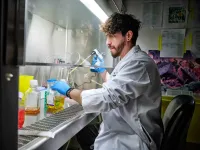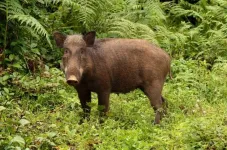That's when the H1N1/09 swine flu emerged, eventually infecting upwards of 1.4 billion people -- nearly one of every five on the planet at the time. True to the name, swine flus jump to humans from pigs. It's a phenomenon that has been documented more than 400 times since the mid-2000s in the United States alone.
"They're considered the great mixing vessel," said Weaver, associate professor of biological sciences at the University of Nebraska-Lincoln. "They're susceptible to their own circulating influenzas, as well as many of the avian and human influenzas.
"If you put an avian, a swine and a human virus into the same cell, they can swap genome segments. When you mix those viruses in the swine, what pops out could be all swine, or a little human and swine, or a little avian and swine, or a little of all three. And you never know: You might get the perfect combination of parts that makes for a very high-fitness virus that is highly transmissible and new to humans, meaning that people don't have immunity to it."
All of it helps explain why Weaver has spent years researching how to develop a vaccine that protects against as many strains of influenza as possible, including those that have yet to emerge. In a new study, Weaver, doctoral candidate Brianna Bullard and colleagues have debuted the results of an approach that demonstrates promising signs of protection against more than a dozen swine flu strains -- and more than a leading, commercially available vaccine.
"This is the best data I've ever seen in the (research) literature," Weaver said of the team's findings, recently published in the journal Nature Communications.
The "H" and "N" in H1N1 refer to two crucial proteins, hemagglutinin and neuraminidase, that reside on the surface of influenza viruses and allow them to enter and exit cells. But it's the H3 subtype of influenza -- H3N2, specifically -- that has accounted for more than 90% of swine-to-human infections in the United States since 2010, making it the target of Weaver's most recent research.
In his efforts to combat multiple strains of swine H3N2, Weaver employed a computational program, Epigraph, that was co-developed by Bette Korber of Los Alamos National Laboratory. The "epi" is short for epitope: the bit of a viral protein, such as hemagglutinin, that draws the attention of an immune system. Any one epitope, if administered as a vaccine, will stimulate an immune response against only a limited number of closely related viral strains.
So Weaver put Epigraph to work analyzing data on every known and available mutational variant of hemagglutinin, which it then used to predict which collection of epitopes would grant immunity against the broadest, most diverse range of strains. Those hemagglutinin proteins are usually composed of around 560 amino acids, whose type and sequence determine the structure and function of the epitopes. Starting at the start of an amino acid string, Epigraph analyzed the sequence of amino acids No. 1 through No. 9 before sliding down to analyze Nos. 2-10, then 3-11, and so on. After doing the same for every epitope, the program determined the most common nine-acid sequences from the entire batch -- the entire catalogue of known H3N2 strains in pigs.
"So what you end up with are the most common epitopes that exist in nature linked together, then the second-most common, and then the third-most common," Weaver said. "When you look at it from an evolutionary standpoint, the first resembles what most of the viruses look like. The second starts to look a bit different, and the third looks even more different.
"But all three of these make a contribution to the vaccine itself, and they work through slightly different mechanisms."
When testing the resulting three-epitope cocktail in mice and pigs, the team found that it yielded immune response signatures and physiological protection against a much wider variety of strains than did FluSure, a commercial swine vaccine.
In mice, the team tested its vaccine against 20 strains of swine-derived H3 flu. The vaccine generated clinically relevant concentrations of antibodies -- the molecules that neutralize a virus before it enters a cell -- against 14 of those 20 strains. FluSure managed the same feat against just four of the 20. A separate experiment presented the mice with four strains that represented a cross-section of H3 diversity. In all four cases, Epigraph-vaccinated mice produced notable levels of T-cells, which, among other responsibilities, instruct infected cells to die for the sake of avoiding further viral transmission. FluSure-vaccinated mice, by contrast, showed little T-cell response to any of the four strains.
Those cellular-level responses appeared to scale up, too. When challenged with flu viruses, Epigraph-vaccinated mice generally lost less weight, and exhibited fewer viral particles in the lungs, than did their FluSure-vaccinated counterparts. And when mice were challenged with a lethal H3 strain derived from humans, only the Epigraph vaccine protected all of the specimens that received it.
That performance carried over to pigs. Cells taken from swine injected with just one dose of the Epigraph vaccine produced substantial antibodies in response to 13 of 20 H3 strains, including 15 of 16 that originated in North America or were derived from humans. A single dose of FluSure, meanwhile, generated significant antibodies against none of the 20. Though a second dose of FluSure did elevate those antibody concentrations, they remained about four times lower, on average, than the Epigraph-induced responses. T-cell responses, too, remained higher in Epigraph-vaccinated pigs.
More, and more-generalizable, experiments will be needed to verify the Epigraph vaccine's performance, Weaver said. For one, the team is looking to test whether the vaccine candidate generates actual immunity in living pigs, beyond the promising immune responses from their cells in a lab. There's also the matter of determining how long any immunity might last.
But Weaver has already developed a human equivalent of the swine flu vaccine cocktail that he's likewise preparing to test. Considering the similarities between flu infections in humans and pigs -- susceptibilities to subtypes, clinical symptoms, even viral receptors in respiratory tracts -- he said the recent findings bode well for those future, human-centric efforts. Success on that front could eventually mean pivoting away from the current approach to flu vaccinations, whereby virologists are forced to predict which strains will dominate a flu season -- and, despite their best efforts, sometimes miss the mark.
"This study is equivalent to a bench-to-bedside study, where the positive results in the preclinical mouse study are confirmed by positive results in a clinical pig study," Weaver said. "This gives us confidence that when the concept is applied to human influenza virus, we'll see the same translation from preclinical studies to clinical studies in humans."
INFORMATION:
Weaver, Bullard and Korber authored the Nature Communications study with Brigette Corder, doctoral student at Nebraska, along with Richard Webby, Jennifer DeBeauchamp and Adam Rubrum of St. Jude Children's Research Hospital. The team received support from the National Institutes of Health.




